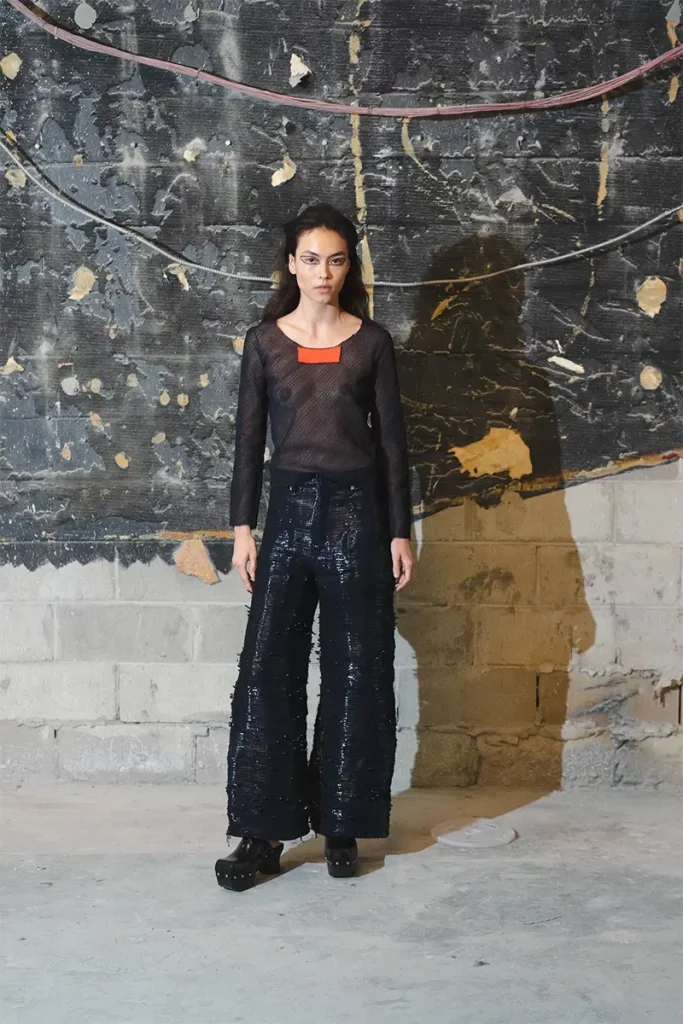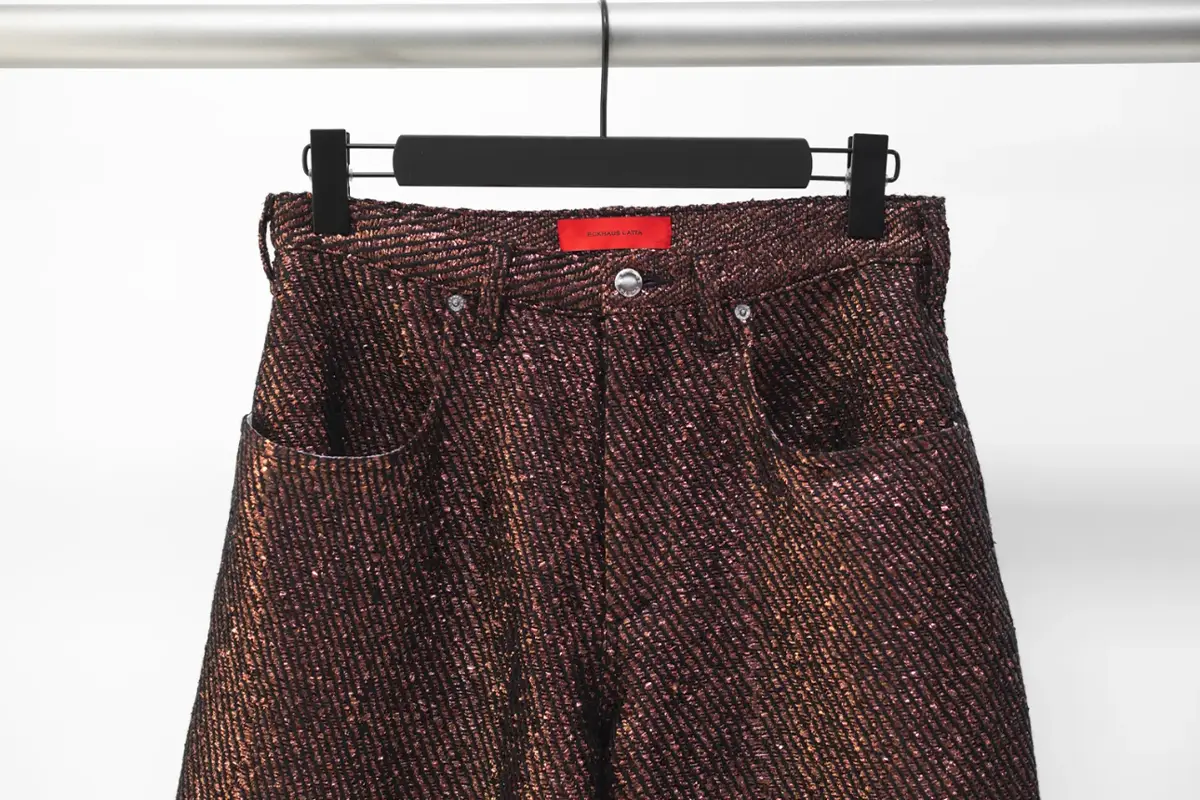Luxury fashion brands are also to blame for excessive waste in the industry. Eckhaus Latta collection at NYFW features first pieces made with Unspun’s Vega™3D weaving technology
Unspun’s Vega™ Technology: Eckhaus Latta presents at New York Fashion Week first 3D-made clothes
The traditional clothing manufacturing process has seen minimal change over the past few decades, with fabric being produced on flat looms, cut into pieces, and then sewn together, resulting in wastage at each stage. Vega™, a 3D weaving technology developed by the creators Unspun, debuted with the new Spring Summer 2024 collection by Eckhaus Latta at New York Fashion Week presenting clothes made with circular loom that weaves yarn into tubes instead of flat sheets, eliminating waste during the cutting process.
While 3D technology isn’t novel in textile production, Unspun’s premise is to utilize it for large-scale circular fabric creation.
The collaboration between Unspun and Eckhaus Latta presented as an opportunity for the brand to introduce this technology to the world of high fashion. The collection, showcased at 45 Rockefeller Plaza, featured several pieces crafted using Vega™ technology: wide-leg pants woven with metallic foil yarn and others made from twine and plastic, contrasting the rugged textures with soft knit or slinky mesh tops.
Vega™ by Unspun – The 3D weaving machine: from iPhone scan to tailored pieces of clothing
The paradigm of Unspun revolves around the creation of garments on demand, drastically reducing overproduction and eliminating the generation of unused fabric scraps. Its strength is the elimination of entire steps in the traditional cut-and-sew process.
The 3D weaving machine, debuted in November 2022, operates to accommodate each individual buyer’s specifications, by taking raw yarn as input.
At the start of the process, an iPhone body scan captures 30,000 data points to create a custom design in the chosen fabric and style. It later employs an advanced algorithm to swiftly tailor sizing as each tube is formed. Lastly, the topographical weaving machine is launched; it can craft a pair of jeans in only 10 minutes.
Back in 2015, when Unspun was founded, they started with the concept of creating custom-fit jeans on demand. Developing weaving technology was the goal right from the company’s inception.
Unspun’s Vega™ addresses issues of excess inventory, material waste, and achieving circularity
Unspun’s production system paves the way for circularity by facilitating the reuse of yarn at the end of a product’s life cycle. These are critical steps in addressing the colossal issues of excess inventory, material waste, and achieving circularity that have long plagued the fashion industry.
Beth Esponnette, one of Unspun’s co-founders, explained their motivation: «When I first grasped the issue of textile waste, the only solutions discussed were either burning excess clothing, exporting it to other countries, or simply disposing of it. No one questioned why this was a problem in the first place or considered how it could be prevented. That’s why we aimed to address this issue at the design stage».
Kevin Martin, another co-founder, emphasized that this represents a pivotal moment for technology in the industry: «This is the first time technology has reached a point where we can contemplate alternative manufacturing methods. By reevaluating the key assumptions about how clothing is made and leveraging technology to reinvent the entire system, we can bring about profound changes. This transformation should be seen as an upgrade to the industry rather than a complete replacement».
Lowercarbon Capital $14 million investment to support Unspun’s Vega™ 3D weaving
Unspun has recently secured $14 million in Series A funding to support Vega™. Led by Lowercarbon Capital, this funding will primarily fuel the expansion of Unspun’s manufacturing capabilities for its Vega™ technology, initially conceived to address the demand for sustainable production methods.
By reducing the time of the whole manufacturing process, transportation costs and emissions are lowered. This approach enables products to be crafted on demand, granting brands greater control over their production.
The risk, once the finished product is being put out there, is the inability to live up to some sustainability claims.
To enhance future efforts, Unspun is exploring methods to recover and reuse yarn from completed garments. If the 3D weaving machines can accommodate various types of yarn, it opens the door to additional recycling possibilities. This may involve the utilization of synthetic yarns crafted from recycled plastics, repurposed carbon materials, and other waste sources.

Unspun’s Vega™ new fashion microfactories bring manufacturing closer to the brand’s end consumers
Reducing the ecological footprint of the textile manufacturing process starts with optimization.
The funding directed towards Unspun’s expansion will be also utilized for the development of microfactories. Microfactories scattered throughout the territory eliminate the need for middle-mile logistics to reduce global greenhouse gas emissions, water waste, and plastic pollution and deploy a more streamlined supply chain.
The number of intermediaries and locations involved in the supply chain are reduced, improving stability and flexibility, effectively shielding logistics networks from potential bottlenecks, adverse macroeconomic shifts, geopolitical changes, and extreme weather events.
By shortening the time it takes for raw materials to reach the end customer, the microfactories engage in small-batch production with minimal inventory or even on-demand manufacturing with no inventory, allowing for swift adjustments in response to market dynamics. Lastly, it encourages a stronger emphasis on local operations.
When expenses associated with supply chain management are reduced, nearshore or onshore production is financially viable without compromising competitiveness in the market, all while maintaining the ability to fulfill orders.
Unspun’s Vega™ – fashion waste is a problem for everybody, luxury brands included
Despite a growing awareness of the clothing waste problem within the fashion industry, the issue continues to escalate, and it’s expected to increase by 70 percent by 2050. Each year, an estimated 11.3 million tons of textile waste are discarded in the United States alone, finding their way into landfills and overcrowded second hand markets worldwide. This problem transcends fast fashion and extends to the entire fashion spectrum, including luxury brands. Despite numerous partial solutions like recycling and upcycling, few effectively tackle the root causes of textile waste – overproduction and inefficient manufacturing processes.
Beyond the design and materials, the appeal of luxury fashion stems from its exclusivity, given its high cost, which elevates it to a symbol of status. Instead of offering surplus stock at reduced prices, certain luxury brands opt to eliminate it altogether to uphold their brand’s prestige and exclusive image.
Part of the problem lies in the existence of a ‘grey market’ where authentic designer items are acquired at lower prices and resold by third parties. Some brands even extend discounts to their employees and industry insiders to reduce the amount of unsold inventory and prevent it from falling into the hands of resellers. Luxury brands may also have a financial motivation for disposing of unsold stock.
At the base of production, fashion designers should recognize waste as a design flaw and prioritize waste reduction efforts. This transition should shift away from a linear model and embrace a more circular system that places value on recycled and reclaimed products, emphasizing the durability and life cycle of our possessions.
Unspun
American fashion and technology company based in San Francisco, California. In November 2022, Unspun invented the world’s first pair of 3D woven pants built unique to each consumer via body scan. Unspun’s patented 3D weaving method enables more efficient automated garment manufacturing reducing costs of production and textile waste.



















